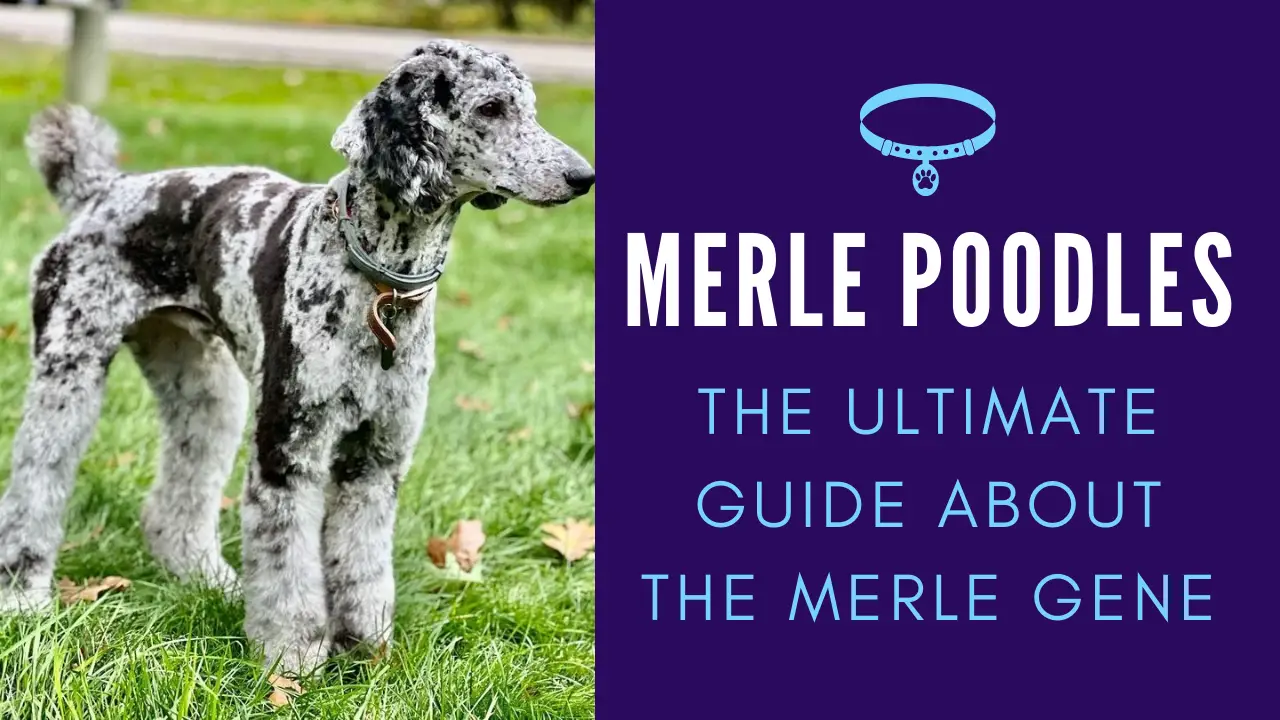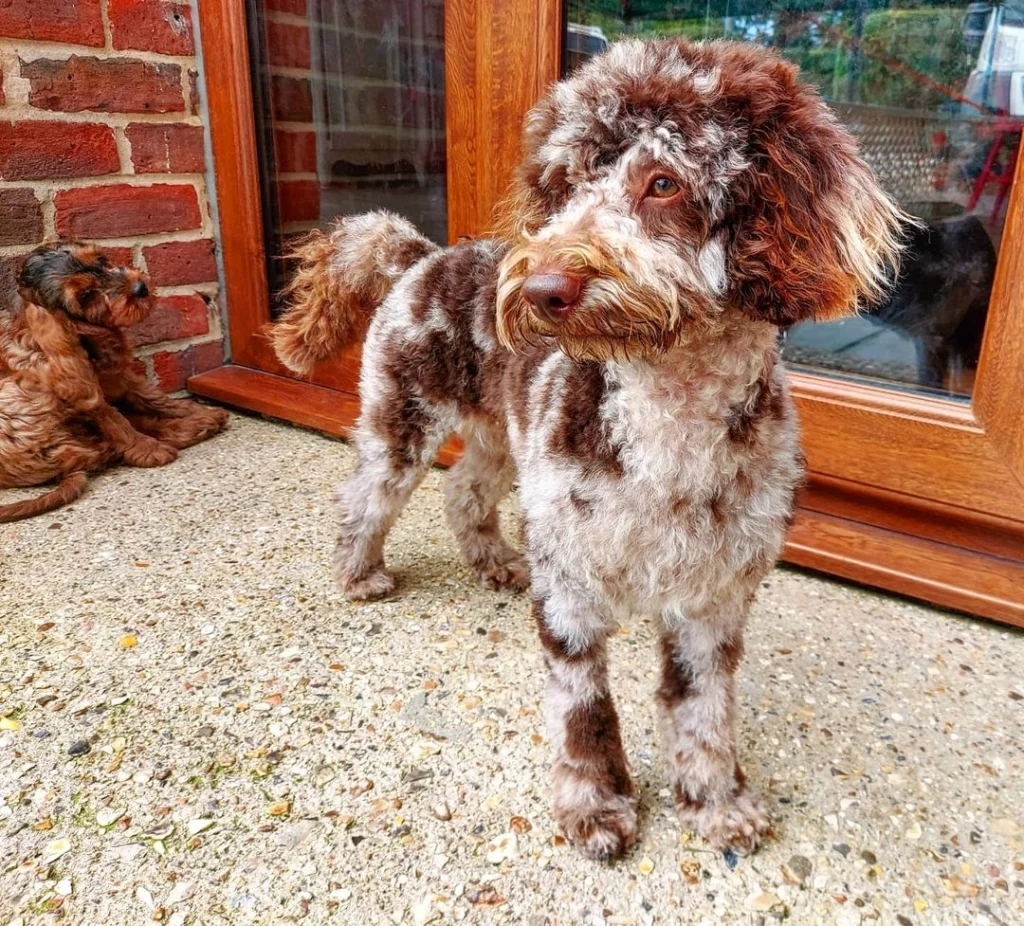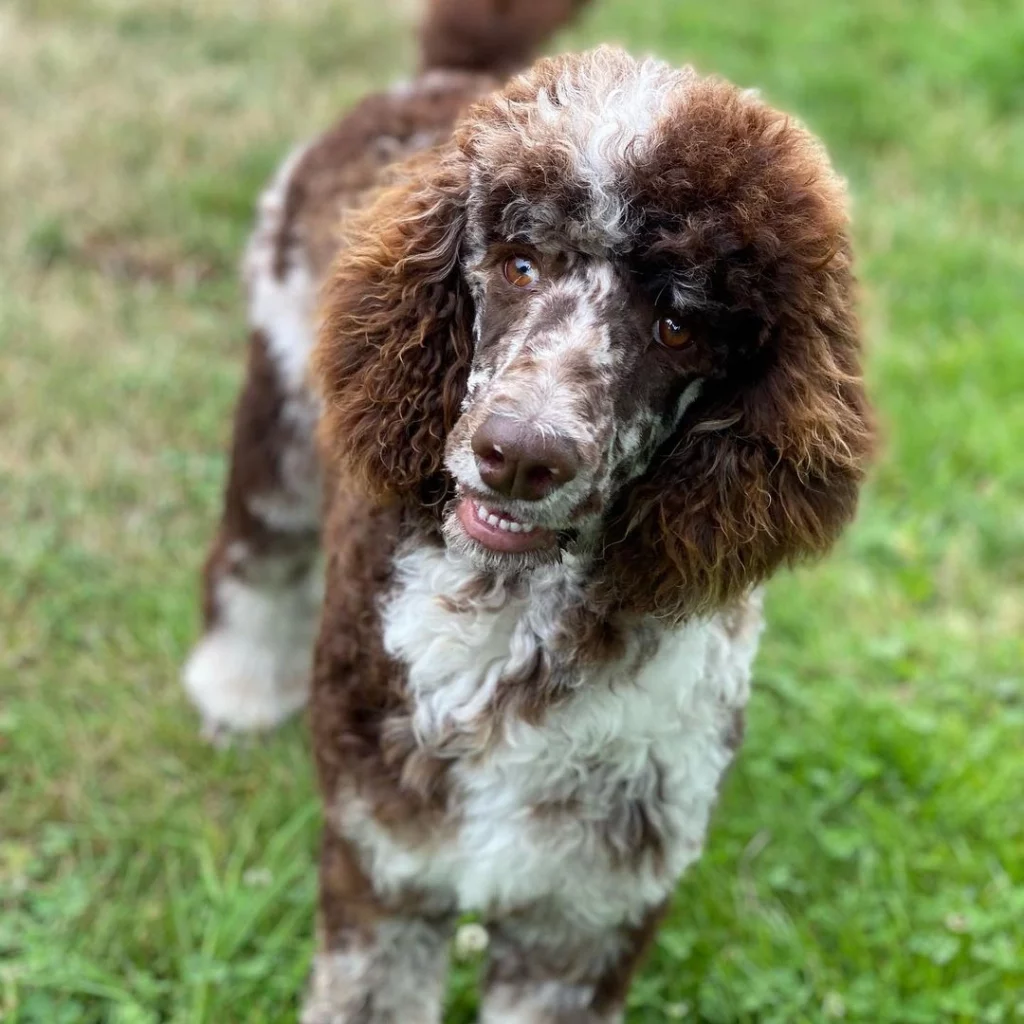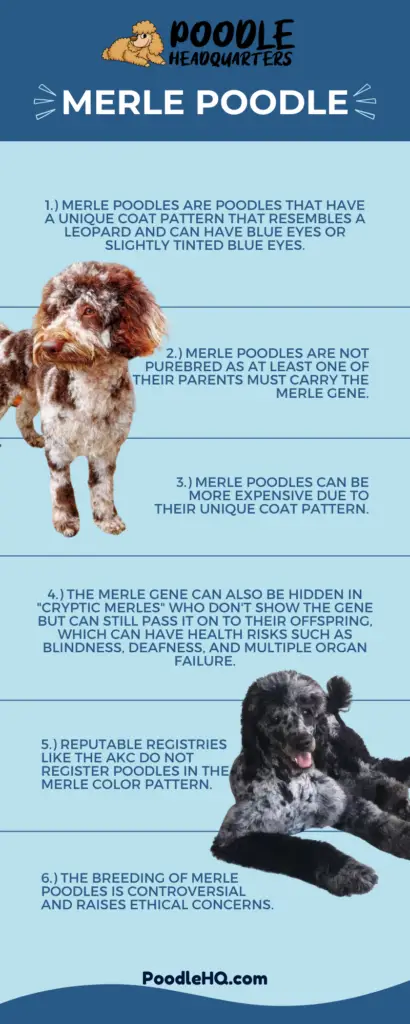What Will You Learn? 👇
What are merle poodles?
This type of dog has all the similar behaviors and traits a Poodle is known for, but technically is not a poodle and there is a significant difference in their coat. The pattern of their coat is kind of similar to a Leopard.

The word “Merle” is directly related to the pattern of the coat and not the color.
A Merle coat can be found in all three types of Poodle: the Standard, Miniature, and Toy.

Read our Smart Poodles - Smart Tricks eBook for only $2.99
Dive into a treasure trove of engaging tricks and tips designed specifically for your poodle!
In addition to their coat, a Merle doodle can face another unique trait: they have blue eyes or slightly tinted blue ones. Similarly, they can often have a pink and black pigment in their nose and paw pads.

How do you get merle doodles?
A Merle can only exist if they carry the “Merle gene”. Now regarding this gene, it can exist naturally in some breeds. However, when it occurs in the Poodle, it can cause some element of doubt. Usually, this is because it was a result of breeding with another dog carrying the merle gene.
Are merle poodles purebred?
Due to how a Poodle inherits the Merle gene, there’s no way they can be purebred. At least one of their parents must have it, and that occurs as a result of crossbreeding. It’s believed a lot of Merle Doodles that come into existence result from breeders who have deliberately bred Poodles for a better aesthetic. The reason they do this is so they can sell them for a higher price.
However, some breeders also tend to believe that the Merle gene has always existed in the Poodle breed, and it’s one that’s been dormant in their blood throughout history, something which is not true at all.
Many argue that the gene was previously hidden in former breeding practices as other breeders favored Poodles with solid-colored coats. Similarly, many people simply believe that the Merle gene was a mutation that later occurred in a Poodles bloodline. All of these statements are not correct at all.
But, in this scenario, you should not go off the breeder’s advice; you should favor credible organizations like the American Kennel Club (AKC). Now according to the AKC, Merle Doodle’s are not registered as poodles.
When the Merle Gene is Bred Into Poodles
I got in touch with Myka Shaw, from Myka and Lisa’s Coast to Coast Poodles, a breeder specializing in purebred Standard Poodles to get more expertise on this topic, “As a preservation breeder of purebred poodles in solid and multi-colors, I’m often approached with the subject of the Merle gene in poodles. My short answer is that those are doodles and the gene came from another breed such as an Australian Shepard but it’s much more complex than simply having a doodle result from breeding these.
The Merle gene can be hidden in red, white, & cream-colored poodles. Those are called “Cryptic Merles”… these dogs carry the gene but don’t show it which is problematic not just because someone unknowingly has a mixed breed but also because two dogs bred together that carry the Merle gene have horrible health risks such as blindness, deafness, and multiple organ failure. People don’t realize they have a mixed breed and don’t know to watch for these risks when breeding, registration papers are falsified at some point to register these dogs and that throws in another breeds temperament and conformation as well as health risks.
AKC, CKC, UKC nor any other reputable registry will register poodles in the Merle color pattern. Poodles already naturally carry phantom, brindle, parti, sable and various solid colors. There’s already so much variety that is in line with poodle breed standards that there is no reason to want to add such a dangerous gene to our breed. It changes all aspects of the purebred Poodle.”
Possible merle coats
When it comes to the coat, there are three distinct types that can be observed: blue, chocolate, and parti.

Blue: Often it’s not unusual for a blue merle to be called a grey merle. This is mainly due to them having a grayish-blue coat with faded spotting that is located across their coat. The spotting will tend to have white and grey colors.
Chocolate: The chocolate colored coat that exists in a merle is an extremely hard one to find. This type of coat can be a bit difficult to detect. In this case, a Poodle will have a brown or black coat with light blue tints on it.
Parti: Sometimes a Merle can have two distinct solid colors running through their coat, known as parti. These types of Poodles will usually be black and white, red and white, or white and brown. Normally the base color is a blueish-grey with different colored spotting.
How big do merle doodles get?
Sometimes a Merle doodle can vary based on its size. Their sizes range from:
- Standard Poodle: Usually, Standard Merle can weigh between 40-55lbs / 18-122lbs and grow up to 15inches / 38cm at shoulder height.
- Miniature Poodle: These Merle’s can weigh between 12-15lbs / 5-7kg and grow up to 10-15inches / 25-38cm at shoulder level.
- Toy Poodle: Typically, Toy Merle’s can weigh between 5-10lbs / 2-5kg and grow up to 10inches / 25cm at shoulder height.
Do merle doodles fade?

Those Poodles that do tend to change coat color are not Merle’s, and they usually have a single solid coat color such as red, blue, or silver. Part of the reason for this is that they have a dilute gene that takes time to show. However, the Merle gene is already diluted and present in different areas when the doodle is born.
Are merle doodles healthy?
Most of the time, the Merle Doodle is a healthy dog. However, if they’re predisposed to certain medical conditions, it can dramatically shorten their life expectancy.
The common diseases a Doodle can face in its lifetime are:
Addison’s disease: Addison’s disease is also known under the medical name Hypoadrenocoritsim. This is a significant medical condition that reduces the number of hormones produced by the adrenal gland.
As a result, they can experience dramatic changes in their body causing difficulty with their heart and circulatory systems. It’s quite hard to detect this disease as there are no specific symptoms to detect. The only main way to diagnose is if their adrenal gland is not working well.
Cushing’s disease: Sometimes Merle Doodle’s can produce too much cortisol, which is known as Cushing’s disease. This usually happens due to a tumor in the pituitary gland, adrenal gland, or extended use of steroids.
Gastric dilation Volvulus: Merle Doodle’s can also have a condition known as bloat. This occurs when their stomach fills up with air, gas, or fluid. As a result, their blood pressure can decrease in blood pressure. Typical signs are eating too much too soon, drinking too much water after eating, and vigorous exercise.
Epilepsy: This is a neurological condition that can occur in Merle Doodles. The condition causes repeated seizures, and treatment normally involves lifelong medication.
Hypothyroidism: This is where they have an underactive thyroid, and their body functions slow down. Typical signs of this are weight gain, lethargy, changes to their hair coat and skin. Treatment for this usually involves medication.
Von Willebrand’s disease: In dogs with VWD, the absence or dysfunction of Von Willebrand factor leads to impaired clot formation and an increased risk of bleeding. This can result in prolonged bleeding from minor injuries or surgical procedures. Dogs with VWD are indeed at higher risk during surgeries because they may have difficulty forming proper blood clots to stop bleeding.
How much do merle Doodles cost?

If you’re looking to buy a Merle Doodle, then you should have a bit of money behind you. This type of doodle is quite expensive and can cost between $800-$5000, and you have to get them from a registered breeder. However, factors such as your location, the size of the Merle, and their age can influence their price.
Breeding a Merle – The Ethics behind it
Breeding a Merle Poodle is quite a controversial topic. The reason behind this is if two Merle Poodles are both bred, there’s a 25% chance of their litter inheriting the double merle gene. Doodles with this gene are more likely to be deaf and blind, which can cause a lot of developmental problems when raising them.

Conclusion
Overall, Merle is a gene that is found in many dogs. Many breeders argue that this gene can be a result of a mutation and something that’s always existed in the Poodle, a statement that is not true. Merle can influence the color of their coat, and because of this, it can cause the prices of a Poodle to increase dramatically.
Typically these Poodles cost between $800-$5000 due to their unique coats. However, everything else, like the personalities, health conditions, and abilities, tends to stay the same as other non-Merle Doodles. But, one of the biggest risks of a Merle Doodle is if they’re bred with another Merle. Doing this can increase the likelihood of a puppy being born blind and deaf.
What’s your opinion on breeding Merle Doodles? Let us know down below.
Marko is the founder and author at PoodleHQ, where he blends profound expertise with formal training in Animal Behavior and Canine Genetics. With multiple generations of poodles under his care, he’s a breed connoisseur, honored with the Canine Care Excellence Award and lauded by the International Pet Enthusiasts Association.


There is good information here. Merles can also have smaller eyes or bulging eyes. It is my belief that all people advertising AKC registered merle pattern poodles should have those papers revoked and be banned from the AKC registry for life. They have falsified the color classification to get papers or used papers from a true poodle puppy that passed after the litter was registered and that is called “hanging papers” on a puppy that does not deserve it. Any merle puppy sold as a poodle is fraud. They are a doodle not a poodle. I am also a conservation standard poodle breeder and will not support merle or doodling in any way.
I completely agree with you Debra.
As a breeder of UKC Champion Particolored Standard Poodles I take offense at Merle patterned doodles being called Parti! By United Kennel Club (UKC) definition a Parti must be “50% or more white” with the balance being patches of “any other approved poodle color.” Merle does not fall into this category. Further more, Parti Poodles have been present since the inception of the breed, dating back to the1600s, as depicted in artwork of the time.
The words merle and Poodles should NEVER be combined, as this color pattern is not natural to the breed.
Another health caveat is the possibility of the Merle dog carrying the gene mutation called MDR1. This gene makes carrier dogs susceptible (at risk of death) if exposed to Ivermectin or Trifexis, both popular for treatment of parasites, both internal and external.
I also concur with Debra Sterns’ comments.
How can a breeder claiming merles are AKC registered be reported?
Hi there,
Here is the link where you can find the instructions on making a complaint:
https://www.apps.akc.org/apps/contact/answer_center/faq_resolveconflict.cfm
Hi Larry
You can send as much info as you can to AKC at the email address:
Impurebreeding@AKC.org
Best to link a website, name of breeder or seller, dogs’ registered names and numbers, pictures, etc.
hello, can you tell me how one can determine if a Merle doodle has the MDR1 gene mutation? Thank you.
Hi Julie.
There is a test called MDR1 test. It can be done by your vet by extracting blood from your dog, and sometimes even a cheek swab can be enough. The test costs around $60, but your vet should tell you if there is a need for you and your dog to go through this process.